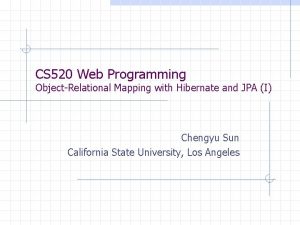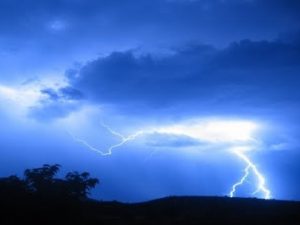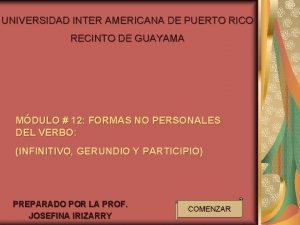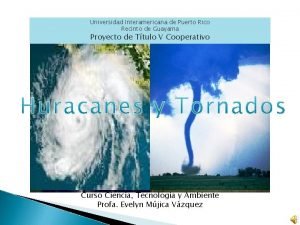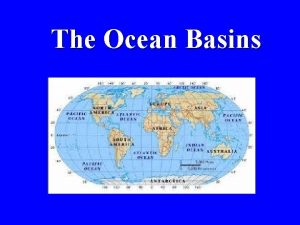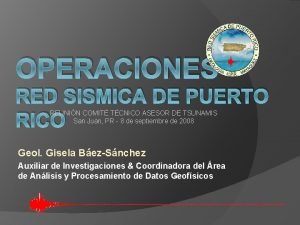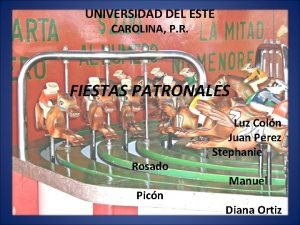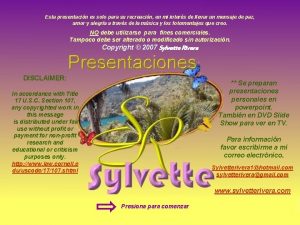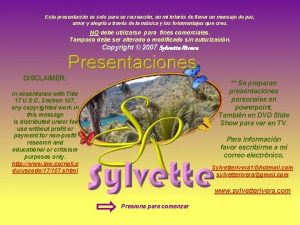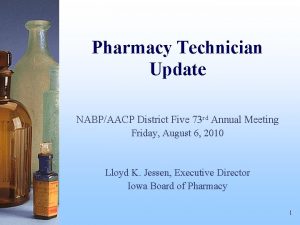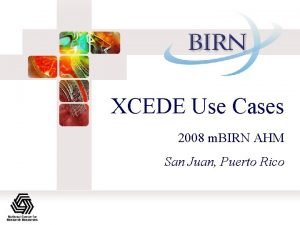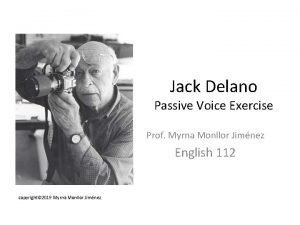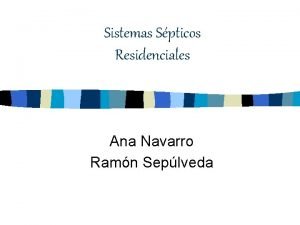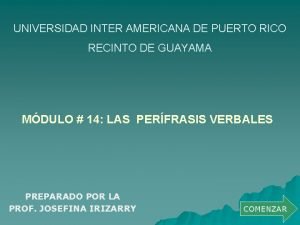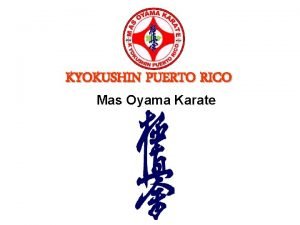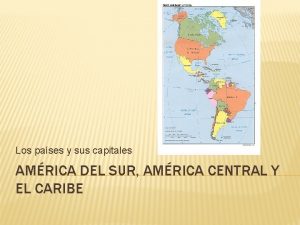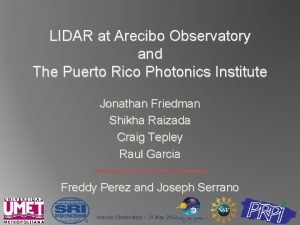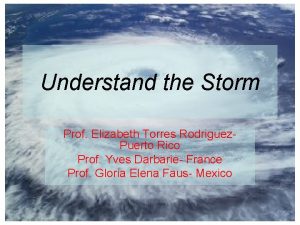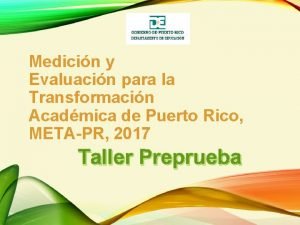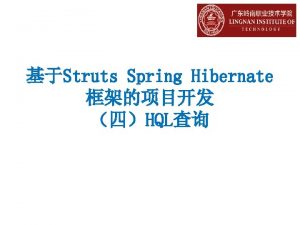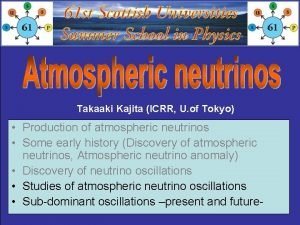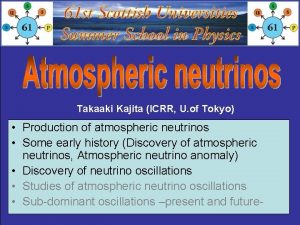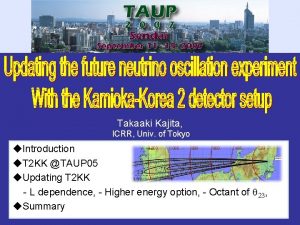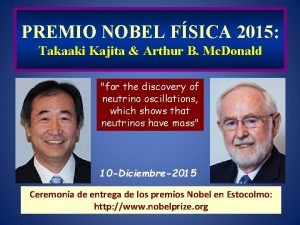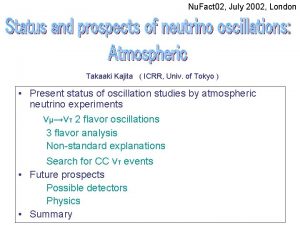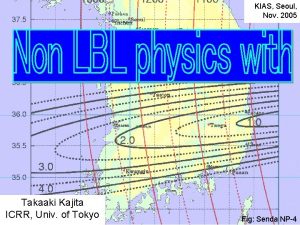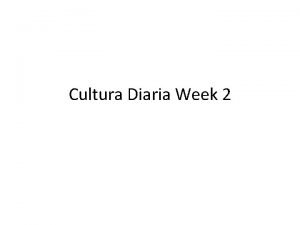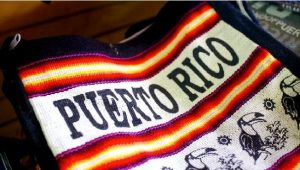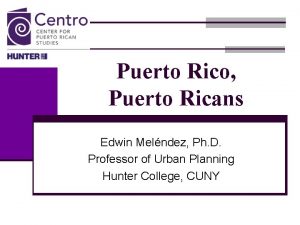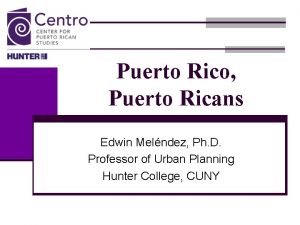HQL 2004 Puerto Rico MayJune 2004 Takaaki Kajita






































- Slides: 38

HQL 2004, Puerto Rico, May-June. 2004 Takaaki Kajita, ICRR, Univ. of Tokyo

Outline • Atmospheric neutrino beam • Atmospheric neutrinos: Past • Atmospheric neutrinos: Present L/E analysis • Atmospheric neutrinos: Future sub-dominant oscillations ? • Summary

Atmospheric neutrinos Cosmic Ray p, K Atmosphere μ e e e Neutrinos from the other side of the Earth.

Atmospheric neutrino beam Measured cosmic ray proton flux Zenith angle: Flux × En 2 Total nm+nm flux En(Ge. V) nm ne

Event classification Fully Contained (FC) (E ~1 Ge. V) Partially Contained (PC) (E ~10 Ge. V) Stopping (E ~10 Ge. V) Through-going (E ~100 Ge. V)

• 1988: First serious study of the atmospheric neutrino flavor ratio (Kamiokande) • 1991, 92: Confirmation of the atmospheric neutrino problem (IMB) • 1994: Indication for the zenith angle dependent deficit of atmospheric nm (Kamiokande). • 1998: Evidence for oscillation (Super. Kamiokande) Kam. 1988 Data MC e-like (CC ne) 93 88. 5 m-like (CC nm) 85 144. 0 e-like m-like Kam. 1994 SK, 1998 No osc. nm nt osc.

Super-Kamiokande (50, 000 ton water Ch. Detector) 76 m 9. 3 m Soudan-2 (1 kton tracking detector) 12 m MACRO (large muon detector)

SK atmospheric neutrino data 1489 day FC+PC data + 1646 day upward going muon data 1 -ring e-like 1 -ring m-like multi-ring m-like up-going m stopping < 1. 3 Ge. V No osc. Osc. > 1. 3 Ge. V Up-going Down-going Through going

Soudan 2 • 5. 9 kton・yr exposure • Partially contained events included. • L/E analysis with the “high resolution” sample Reconstructed Lν/ Eν dist. Phys. Rev. D 68 (2003) 113004 Zenith angle e Upgoing μ Downgoing e μ No osc. nm nt osc.

MACRO PLB 566 (2003) 35 Multiple scattering Oscillation Em Δm 2 =2. 5× 10 -3 En L /E or Upward horizontal

Neutrino oscillation parameters (90%CL) nm→nt Soudan-2 Kamiokande Super-K MACRO (Prelim. 90%CL) (Note: the final SK-1 nm nt oscillation results will be presented in 10 days. )

Ne w n oscillation SK collab. hep -ex/0404034 ! -like multi-Ge. V + PC n decoherence n decay Should observe this dip! Further evidence for oscillations Strong constraint on oscillation parameters, especially Dm 2

Selection criteria m Full osc. Half osc. m Select events with high L/E resolution (D(L/E) < 70%) Following events are not used: ★horizontally going events ★low energy events

L/E distribution 1489 days FC+PC (Super-K) Mostly up -going MC (no osc. ) Mostly down -going Best fit expectation w/ systematic errors First dip is observed as expected from neutrino oscillation

Allowed neutrino oscillation parameters 1. 9 x 10 -3 < Dm 232 < 3. 0 x 10 -3 e. V 2 0. 90 < sin 22 q 23 (90% C. L. ) c 2 min=37. 9/40 d. o. f @ Dm 2=2. 4 x 10 -3, sin 22 q=1. 00 (sin 22 q=1. 02, c 2 min=37. 8/40 d. o. f) 90% allowed regions Soudan 2 K 2 K L/E analysis MACRO Zenith angle analysis Consistent with that of the standard zenith angle analysis

Neutrino decay and decoherence models ? Oscillation Decay Decoherence c 2 min=37. 9/40 d. o. f c 2 min=49. 1/40 d. o. f Dc 2 =11. 3 c 2 min=52. 4/40 d. o. f Dc 2 =14. 5 n decay disfavored at 3. 4 s n decoherence at 3. 8 s First dip observed in the data cannot be explained by alternative hypotheses Evidence for oscillatory signature

Present: Study of dominant oscillation channel (nm nt) Future: Study of sub-dominant oscillations ★q 13? ★Mass hierarchy? ne nm ν mass ★Solar oscillation effects? nt n 3 n 2 n 1 Normal mass hierarchy is assumed.

Possible future atmospheric n detectors Very large water Cherenkov detector Hyper-K (1 Mton) Magnetized large tracking detector MONOLITH, INO (Indian Neutrino Observatory, …

Search for non-zero q 13 (Dm 122=0 assumed) M at te re ffe ct MC, SK 20 yrs 1+multi-ring, e-like, 2. 5 - 5 Ge. V SK Present result (Note: will be updated in 10 days) cos. Q Electron appearance s 213=0. 05 s 213=0. 00 null oscillation En(Ge. V) cos. Q Electron appearance in the 5 – 10 Ge. V upward going events. (And stronger muon disappearance in the 5 – 10 Ge. V upward going events. )

Sensitivity for non-zero q 13 Importance of s 2 q 23>0. 5; S. Pascoli et al. , hepph/0305152 Water Cherenkov detector 450 kton・yr (SK 20 years) 3 s 3 s ~ Present bound on sin 2 q 13 (Dc 2 ∝~ exposure) 3 s

Sign of Dm 23(13)2 ? How can we discriminate positive and negative Dm 2 ? Real Dm 232 = positive assumed Real Dm 232 = negative assumed n 2 n 1 P(nm ne) cos. Q P(nm ne) n 3 En(Ge. V) (No resonance for anti-neutrinos) En(Ge. V) (No resonance for neutrinos) n 2 n 1 n 3

2 Measurement of θ 13 and sign of Δm ? Matter effect Δm 2=2. 5× 10 -3 sin 2θ 13=0. 02 Charge identification (Magnetized tracking detector) Determination of sign of Δm 2 at 90%CL. NPB (proc suppl) 91 (2001) 147, hep-ex/0106252

Electron appearance for positive and negative Dm 2 in a water Chrenkov detector Single-ring e-like Relatively high anti-ne fraction Dm 2=0. 002 e. V 2 s 2 q 23 = 0. 5 s 2 q 13 = 0. 05 (SK 20 yrs) Multi-ring e-like Lower anti-ne fraction Positive Dm 2 Negative Dm 2 null oscillation cos. Q

c 2 difference (inverted-normal) True= normal mass hierarchy assumed. Dm 2: fixed, q 23: free, q 13: free Exposure: 1. 8 Mtonyr 80 yr or HK ~ 3. 3 yr) 3 s 3 s (SK 3 s

Solar oscillation effects Solar neutrino oscillation: LMA (Dm 122 = 7× 10 -5 e. V 2) Expected number of sub-Ge. V e-like events in SK. Peres, Smirnov NPB 680 (2004) 479 10 1 P. Lipari NOON 2004 The number of e-like events changes as a function of sin 2 q 23 (NOT sin 22 q 23). Discrimination of >45 and <45 q 23 might be possible.

• Atmospheric neutrinos have been playing major role in the neutrino oscillation studies. • The present data are nicely explained by nm nt oscillations with; Dm 2=1. 9 – 3. 0 × 10 -3 e. V 2 sin 22 q > 0. 90 • Recent L/E analysis has shown evidence for “oscillatory” signature. • Future atmospheric neutrino experiments is likely to continue to contribute to the neutrino oscillation physics (q 13, sign of Dm 232 …. ) (If (a) much larger detector, (b) relatively large q 13. )

End

Specials in L/E analysis 1. 5 m from top & bottom FC single-ring, multi-ring -like Expand fiducial volume More statistics for high energy muons 1 m from barrel 22. 5 kt → 26. 4 kt observed charge / expectation from through-going PC Classify PC events using OD charge I. OD stopping II. OD through going Different L/E resolution OD stopping MC OD stopping OD throughgoing MC

Energy and angular resolution of neutrinos

Resolution of L/E and cuts

Sensitivity to other models (determination of L/E resolution cut) 70% 80% n decoherence n decay L/E resolution cut at 70%

Event summary of L/E analysis Fractions of FC and PC samples in L/E distribution MC CC nm FC Data single-ring 1619 2105. 8 (98. 3%) multi-ring 502 813. 0 (94. 2%) PC stopping 114 137. 0 (95. 4%) through-going 491 670. 4 (99. 1%)

Check of the observed dip in L/E distribution (1) Other L/E resolution cuts

Check of the observed dip in L/E distribution (2) FC e-like (Flat L/E distribution is expected. )

Check of the observed dip in L/E distribution (3) zenith angle cosq -cosq (Zenith angle of each event is inverted. Because of the wrong assignment of L, no dip is expected. )

Sensitivities to alternative models and the data n decoherence obtained Dc 2 n decay L/E resolution cut at 70%

How can we discriminate neutrino and antineutrino interactions ? Simple answer: No. It is not possible to discriminate event by event in water Cherenkov experiments. However, s(total) and ds/dy are different. Single-ring e-like Multi-ring e-like Others CC ne Try to discriminate positive and negative Dm 2 using these events.

c 2 difference (normal – inverted) True= inverted mass hierarchy assumed. Dm 2: fixed, q 23: free, q 13: free Exposure: 1. 8 Mtonyr (SK 80 yr or HK ~ 3. 3 yr) 3 s 3 s 3 s
 Hql lead generation
Hql lead generation Hql functions
Hql functions Huracan hortensia en puerto rico
Huracan hortensia en puerto rico Gerundio de puerto rico
Gerundio de puerto rico Huracan hortensia en puerto rico
Huracan hortensia en puerto rico Cuento de juan bobo y el caldero
Cuento de juan bobo y el caldero Alexandra cardona puerto rico
Alexandra cardona puerto rico Est puerto rico
Est puerto rico Reciclaje de papel en puerto rico
Reciclaje de papel en puerto rico Llanos costaneros de puerto rico
Llanos costaneros de puerto rico Loihi seamount
Loihi seamount Desarrollado
Desarrollado Redsismica puerto rico
Redsismica puerto rico Mapa politico puerto rico
Mapa politico puerto rico Fiestas patronales de puerto rico calendario
Fiestas patronales de puerto rico calendario Puerto rico patria mia la tierra de mis amores
Puerto rico patria mia la tierra de mis amores Puerto rico patria mia la tierra de mis amores
Puerto rico patria mia la tierra de mis amores Ptcb exam puerto rico
Ptcb exam puerto rico Ahm puerto rico
Ahm puerto rico Villa sin miedo
Villa sin miedo Puerto rico
Puerto rico Osha 300 puerto rico
Osha 300 puerto rico Pozo séptico prefabricado puerto rico
Pozo séptico prefabricado puerto rico Guam and puerto rico
Guam and puerto rico Gerundio de puerto rico
Gerundio de puerto rico Kyokushin karate puerto rico
Kyokushin karate puerto rico Puerto rico capital
Puerto rico capital Interesting facts about puerto rico
Interesting facts about puerto rico Arahuacos en puerto rico
Arahuacos en puerto rico El yunque national forest puerto rico
El yunque national forest puerto rico Jibaro dress puerto rico
Jibaro dress puerto rico Lidar puerto rico
Lidar puerto rico Elizabeth torres rodriguez puerto rico
Elizabeth torres rodriguez puerto rico Puerto rico language
Puerto rico language Bahamas proper adjective
Bahamas proper adjective Puerto rico webquest
Puerto rico webquest Proyecto 103 puerto rico
Proyecto 103 puerto rico Https//pr.pearsonaccessnext.com
Https//pr.pearsonaccessnext.com Guam and puerto rico
Guam and puerto rico

